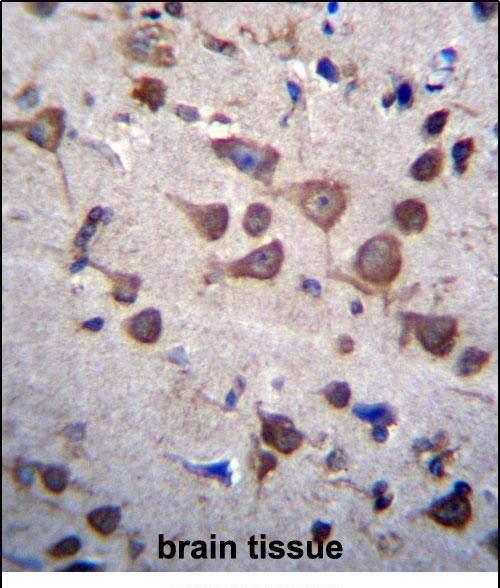PIGA Antibody (C-term)
Affinity Purified Rabbit Polyclonal Antibody (Pab)
- SPECIFICATION
- CITATIONS
- PROTOCOLS
- BACKGROUND

Application
| IHC-P, WB, E |
|---|---|
| Primary Accession | P37287 |
| Other Accession | NP_065206.3, NP_002632.1 |
| Reactivity | Human |
| Host | Rabbit |
| Clonality | Polyclonal |
| Isotype | Rabbit IgG |
| Calculated MW | 54127 Da |
| Antigen Region | 455-484 aa |
| Gene ID | 5277 |
|---|---|
| Other Names | Phosphatidylinositol N-acetylglucosaminyltransferase subunit A, GlcNAc-PI synthesis protein, Phosphatidylinositol-glycan biosynthesis class A protein, PIG-A, PIGA |
| Target/Specificity | This PIGA antibody is generated from rabbits immunized with a KLH conjugated synthetic peptide between 455-484 amino acids from the C-terminal region of human PIGA. |
| Dilution | IHC-P~~1:10~50 WB~~1:1000 E~~Use at an assay dependent concentration. |
| Format | Purified polyclonal antibody supplied in PBS with 0.09% (W/V) sodium azide. This antibody is purified through a protein A column, followed by peptide affinity purification. |
| Storage | Maintain refrigerated at 2-8°C for up to 2 weeks. For long term storage store at -20°C in small aliquots to prevent freeze-thaw cycles. |
| Precautions | PIGA Antibody (C-term) is for research use only and not for use in diagnostic or therapeutic procedures. |
| Name | PIGA (HGNC:8957) |
|---|---|
| Function | Catalytic subunit of the glycosylphosphatidylinositol-N- acetylglucosaminyltransferase (GPI-GnT) complex that catalyzes the transfer of N-acetylglucosamine from UDP-N-acetylglucosamine to phosphatidylinositol and participates in the first step of GPI biosynthesis. |
| Cellular Location | Endoplasmic reticulum membrane; Single-pass membrane protein |

Thousands of laboratories across the world have published research that depended on the performance of antibodies from Abcepta to advance their research. Check out links to articles that cite our products in major peer-reviewed journals, organized by research category.
info@abcepta.com, and receive a free "I Love Antibodies" mug.
Provided below are standard protocols that you may find useful for product applications.
Background
This gene encodes a protein required for synthesis of N-acetylglucosaminyl phosphatidylinositol (GlcNAc-PI), the first intermediate in the biosynthetic pathway of GPI anchor. The GPI anchor is a glycolipid found on many blood cells and which serves to anchor proteins to the cell surface. Paroxysmal nocturnal hemoglobinuria, an acquired hematologic disorder, has been shown to result from mutations in this gene. Alternate splice variants have been characterized. A related pseudogene is located on chromosome 12.
References
Borowitz, M.J., et al. Cytometry B Clin Cytom 78(4):211-230(2010)
Peruzzi, B., et al. Mutat. Res. 705(1):3-10(2010)
Araten, D.J., et al. Mutat. Res. 686 (1-2), 1-8 (2010) :
Iida, Y., et al. Blood 83(11):3126-3131(1994)
Ware, R.E., et al. Blood 83(9):2418-2422(1994)
If you have used an Abcepta product and would like to share how it has performed, please click on the "Submit Review" button and provide the requested information. Our staff will examine and post your review and contact you if needed.
If you have any additional inquiries please email technical services at tech@abcepta.com.













 Foundational characteristics of cancer include proliferation, angiogenesis, migration, evasion of apoptosis, and cellular immortality. Find key markers for these cellular processes and antibodies to detect them.
Foundational characteristics of cancer include proliferation, angiogenesis, migration, evasion of apoptosis, and cellular immortality. Find key markers for these cellular processes and antibodies to detect them. The SUMOplot™ Analysis Program predicts and scores sumoylation sites in your protein. SUMOylation is a post-translational modification involved in various cellular processes, such as nuclear-cytosolic transport, transcriptional regulation, apoptosis, protein stability, response to stress, and progression through the cell cycle.
The SUMOplot™ Analysis Program predicts and scores sumoylation sites in your protein. SUMOylation is a post-translational modification involved in various cellular processes, such as nuclear-cytosolic transport, transcriptional regulation, apoptosis, protein stability, response to stress, and progression through the cell cycle. The Autophagy Receptor Motif Plotter predicts and scores autophagy receptor binding sites in your protein. Identifying proteins connected to this pathway is critical to understanding the role of autophagy in physiological as well as pathological processes such as development, differentiation, neurodegenerative diseases, stress, infection, and cancer.
The Autophagy Receptor Motif Plotter predicts and scores autophagy receptor binding sites in your protein. Identifying proteins connected to this pathway is critical to understanding the role of autophagy in physiological as well as pathological processes such as development, differentiation, neurodegenerative diseases, stress, infection, and cancer.



